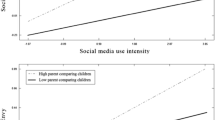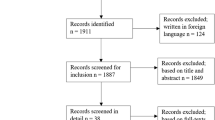Abstract
The research literature suggests that the structural characteristics of video games may play a considerable role in the initiation, development and maintenance of problematic video game playing. The present study investigated the role of structural characteristics in video game playing behaviour within a sample of 421 video game players aged between 14 and 57 years. Players were surveyed via an online questionnaire containing measures of video game playing behaviour, player interaction with structural characteristics of video games, and problematic involvement in video games. The results showed that the reward and punishment features, such as earning points, finding rare game items, and fast loading times, were rated among the most enjoyable and important aspects of video game playing. There was some evidence that certain structural characteristics were stronger predictors of problematic involvement in video games than factors such as gender, age, and time spent playing. This research supports the notion that some structural characteristics in video games may play a significant role in influencing problem playing behaviour. Implications for theory and future research are discussed.
Similar content being viewed by others
Notes
A full discussion of all five taxonomic categories can be found in King et al. (2010a), but not reported here due to space limitations.
References
Blaszczynski, A. (2008). Commentary: a response to “problems with the concept of video game “addiction”: some case study examples”. International Journal of Mental Health and Addiction, 6, 179–181.
Blaszczynski, A., McConaghy, N., & Frankova, A. (1990). Boredom proneness in pathological gambling. Psychological Reports, 67, 35–42.
Blaszczynski, A., Sharpe, L., Walker, M., Shannon, K., & Coughlan, M.-J. (2005). Structural characteristics of electronic gaming machines and satisfaction of play among recreational and problem gamblers. International Gambling Studies, 5, 187–198.
Brown, I. (1997). A theoretical model of the behavioural addictions—Applied to offending. In J. E. Hodge, M. McMurran, & C. R. Hollins (Eds.), Addicted to crime? (pp. 13–65). Chichester: Wiley.
Chappell, D., Eatough, V., Davies, M. N. O., & Griffiths, M. D. (2006). Everquest—It’s just a computer game right? An interpretative phenomenological analysis of online computing addiction. International Journal of Mental Health and Addiction, 4, 205–216.
Charlton, J. P. (2002). A factor-analytic investigation of computer ‘addiction’ and engagement. British Journal of Psychology, 93, 329–344.
Charlton, J. P., & Danforth, I. D. W. (2007). Distinguishing addiction and high engagement in the context of online game playing. Computers in Human Behaviour, 23, 1531–1548.
Chui, S.-I., Lee, J.-Z., & Huang, D.-H. (2004). Video game addiction in children and teenagers in Taiwan. Cyberpsychology & Behavior, 7, 571–581.
Chumbley, J., & Griffiths, M. D. (2006). Affect and the computer game player: the effect of gender, personality, and game reinforcement structure on affective responses to computer game play. Cyberpsychology & Behavior, 3, 308–316.
de Freitas, S., & Griffiths, M. (2008). Massively multiplayer roleplay games for learning. In R. Ferdig (Ed.), Handbook of research on effective electronic gaming in education (vol. 1) (pp. 51–65). Hershey: Idea Group Publishing.
Delfabbro, P., & Winefield, A. H. (1999). The danger of over-explanation in psychological research: a reply to Griffiths. British Journal of Psychology, 90, 447–450.
Fisher, S. (1994). Identifying video game addiction in children and adolescents. Addictive Behaviors, 19, 545–553.
Fisher, S., & Griffiths, M. D. (1995). Current trends in slot machine gambling: research and policy issues. Journal of Gambling Studies, 11, 239–247.
Gee, J. P. (2003). What video games have to teach us about learning and literacy. New York: Palgrave Macmillan.
Griffiths, M. D. (1991). Psychobiology of the near miss in fruit machine gambling. The Journal of Psychology, 125, 347–357.
Griffiths, M. D. (1999). Gambling technologies: prospects for problem gambling. Journal of Gambling Studies, 15, 265–283.
Griffiths, M. D. (2000). Does Internet and computer “addiction” exist? Some case study evidence. Cyberpsychology & Behavior, 3, 211–218.
Griffiths, M. D. (2005). A “components” model of addiction within a biopsychosocial framework. Journal of Substance Use, 10, 191–197.
Griffiths, M. D. (2008). Diagnosis and management of video game addiction. Addiction Treatment and Prevention, 12, 27–41.
Griffiths, M. D., Davies, M. N. O., & Chappell, D. (2004). Demographic factors and playing variables in online computer gaming. Cyberpsychology & Behavior, 7, 479–487.
Grüsser, S. M., Thalemann, R., & Griffiths, M. D. (2007). Excessive computer game playing: evidence for addiction and aggression? Cyberpsychology & Behavior, 10, 290–292.
Jaffe, J. H. (1990). Trivialising dependence [Commentary]. British Journal of Addiction, 85, 1425–1427.
Johansson, A., & Gotestam, K. G. (2004). Problems with computer games without monetary reward: similarity to pathological gambling. Psychological Reports, 95, 641–650.
Kato, P. M., Cole, S. W., Bradlyn, A. S., & Polloch, B. H. (2008). A video game improves behavioural outcomes in adolescents and young adults with cancer: a randomized trial. Pediatrics, 122, 305–317.
King, D. L., & Delfabbro, P. H. (2009a). Understanding and assisting excessive players of video games: a community psychology perspective. Australian Community Psychologist, 21, 62–74.
King, D. L., & Delfabbro, P. H. (2009b). Motivational differences in problem video game play. Journal of Cybertherapy and Rehabilitation, 2, 139–149.
King, D. L., & Delfabbro, P. H. (2009c). The general health status of heavy video game players: comparisons with Australian normative data. Journal of Cybertherapy and Rehabilitation, 2, 17–26.
King, D. L., Delfabbro, P. H., & Griffiths, M. D. (2010a). Video game structural characteristics: a new psychological taxonomy. International Journal of Mental Health and Addiction, 8, 90–106.
King, D. L., Delfabbro, P. H., & Zajac, I. T. (2010b). Preliminary validation of a new clinical tool for identifying problem video game playing. International Journal of Mental Health and Addiction. doi:10.1007/s11469-009-9254-9.
Lemmens, J. S., Valkenburg, P. M., & Peter, J. (2009). Development and validation of a game addiction scale for adolescents. Media Psychology, 12, 77–95.
Ng, B. D., & Wiemer-Hastings, P. (2005). Addiction to the internet and online gaming. Cyberpsychology & Behavior, 8, 110–113.
Parke, J., & Griffiths, M. D. (2007). The role of structural characteristics in gambling. In D. Smith, D. Hodgins, & R. Williams (Eds.), Research and measurement issues in gambling studies (pp. 211–243). New York: Elsevier.
Rockloff, M. J., & Dyer, V. (2007). An experiment on the social facilitation of gambling behavior. Journal of Gambling Studies, 23, 1–12.
Salguero, R. A. T., & Moran, R. M. B. (2002). Measuring problem video game playing in adolescents. Addiction, 97, 1601–1606.
Shaffer, H. J., Hall, M. N., & Vander Bilt, J. (2000). “Computer addiction”: a critical consideration. The American Journal of Orthopsychiatry, 70, 162–168.
Sherry, J. L., Greenberg, B. S., Lucas, K., & Lachlan, K. (2006). Video game uses and gratifications as predictors of use and game preference. In P. Vorderer & J. Bryant (Eds.), Playing video games: Motives, responses and consequences (pp. 248–262). New York: Routledge.
West, R. (2006). Theory of addiction. Oxford: Blackwell Publishing.
Wood, R. T. A. (2007). Problems with the concept of video game “addiction”: some case study examples. International Journal of Mental Health and Addiction, Published online 23 October 2007.
Wood, R. T. A., Griffiths, M. D., Chappell, D., & Davies, M. N. O. (2004). The structural characteristics of video games: a psycho-structural analysis. Cyberpsychology & Behavior, 7, 1–10.
Young, K. (1998). Caught in the net. New York: Wiley.
Author information
Authors and Affiliations
Corresponding author
List of Video Game Structural Characteristics
List of Video Game Structural Characteristics
-
1.
Social interaction, communicating with other players
-
2.
Belonging to a guild, clan or dedicated group
-
3.
Competitive aspects, playing against other people, leaderboard rankings
-
4.
Cooperation, working together to reach goals
-
5.
Sharing tips and strategies about the video game with others
-
6.
Positive comments from other players for skilful play
-
7.
Making friends with other players in the game
-
8.
Needing good reflexes to advance in the game
-
9.
Mastering the controls, learning “combos” or “hot-keys”
-
10.
The tactile sensation or “feel” of controlling the game (including force feedback, button mashing)
-
11.
Managing resources in the game, such as items in your inventory
-
12.
Being able to correct mistakes by reloading a save file
-
13.
Customising in-game features, such as controls, rules, etc.
-
14.
Using cheats to “break” the game
-
15.
Creating your own content for the game, such as making your own maps
-
16.
Taking on a new identity in the game
-
17.
An emotional investment in an in-game character
-
18.
Cut-scenes, extra non-playable story content
-
19.
A complex game story, involving dialogue and narration
-
20.
Different story outcomes based on your player actions
-
21.
Linear story, same events happen every time
-
22.
No endpoint or conclusion to the game
-
23.
“Levelling up” a game character (including non-human characters, like a racing car)
-
24.
Earning points, XP or other rewards
-
25.
Parts of the game based on luck or chance, not skill
-
26.
Being rewarded with rare, unique items for skilful play or playing for a long time
-
27.
Doing the same thing over and over, in order to get a large reward (“grinding”)
-
28.
Getting 100% completion in the game
-
29.
Unlocking meta-game rewards, like “Achievement points” or Trophies
-
30.
Sections of the game that are very difficult and require sustained effort with few mistakes
-
31.
Playing the game on the hardest difficulty, facing very difficult challenges
-
32.
Fast loading times between levels or multiplayer matches, and instant respawning when your character dies
-
33.
Visual aspects, such as high-resolution textures and lighting effects
-
34.
Sound, including music and audio effects
-
35.
Franchise aspects, such as recognisable characters like Mario or Master Chief
-
36.
Adult content, including explicit violence, adult themes
-
37.
Licensed content, including recognisable real-life brands
Rights and permissions
About this article
Cite this article
King, D.L., Delfabbro, P.H. & Griffiths, M.D. The Role of Structural Characteristics in Problematic Video Game Play: An Empirical Study. Int J Ment Health Addiction 9, 320–333 (2011). https://doi.org/10.1007/s11469-010-9289-y
Published:
Issue Date:
DOI: https://doi.org/10.1007/s11469-010-9289-y




